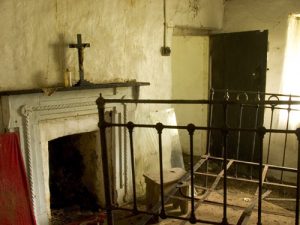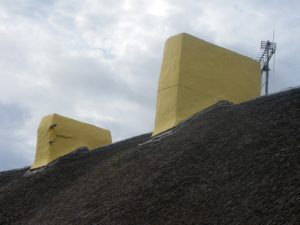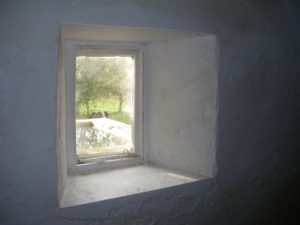 Many people enlist the help of a qualified professional to carry out all the works on their renovation project however there has been a growing movement towards self-builders in an effort to drive down the costs of renovation. While this provides immense personal satisfaction and hands on experience with the project one of the biggest problems encountered is that of safety on site – both for themselves and their property. The following are some of the safety issues and precautions you should be aware of before taking on your renovation. As always I would urge you to engage a fully qualified Engineer to evaluate the structural integrity of the property before you begin any work.
Many people enlist the help of a qualified professional to carry out all the works on their renovation project however there has been a growing movement towards self-builders in an effort to drive down the costs of renovation. While this provides immense personal satisfaction and hands on experience with the project one of the biggest problems encountered is that of safety on site – both for themselves and their property. The following are some of the safety issues and precautions you should be aware of before taking on your renovation. As always I would urge you to engage a fully qualified Engineer to evaluate the structural integrity of the property before you begin any work.
PPE – Personal Protective Equipment
Personal safety is what this article is all about – if you are starting a renovation it pays to have the right gear to hand before you swing that sledgehammer. Things like safety goggles, dust masks and construction gloves are the basics of your safety equipment. Further to that a hard hat and steel toe boots are vital if doing any demolition work. If you are using a cango or any other loud machinery you really do need a set of earmuffs as excessive decibels could harm your hearing in the long term.
Foundations
If you are buying a cottage this is an issue you should have investigated and be aware of before you even purchase the property. Many older Irish cottages do not have any foundations or at the very least they have inconsequential foundations. This is why the walls are often thicker at ground level than near the roof – to provide a stable base. In some cases foundations were dug – a trench into which a bed of stones were laid and the walls built upon these. I can hear you say if they have stood this long then surely there is no problem – all things remaining equal this is true, however several factors can destabilize them. The use of modern materials and techniques may be at odds with traditional building practices. Tools such as cango or electric drills and machinery could destabilize the structure as traditionally all work would have been done by hand or with very rudimentary tools. New materials such as slate and tile could prove to be a much heavier loading on the walls and cause the walls to push outwards as they were originally designed to take the lighter material of thatch.
The remedy for this is to underpin the structure and there are several types of underpinning available. The first is traditional underpinning – digging out trenches at regular intervals around the structure and back-filling them with a more stable material such as concrete. This method is most useful for cottages with shallow foundations and its advantages are that it is relatively lower in cost and is less invasive as it is carried out externally. Piling is another method where steel is used to strengthen the foundations through the insertion of steel and ringbeams. The third is pressure grouting where the foundations are drilled through at angles to a suitable depth and then pumped with grout and a steel rod for strength. Piling should always be carried out by an experienced and registered contractor who will give you a guarantee on their work. This is especially important if there is a remote chance that you might sell the cottage as potential occupiers will want that reassurance.
Another issue which may affect the foundations is ground destabilization which could be caused by geographical movement, development in the vicinity or even by the roots of large trees. An engineer should be able to spot these warning signs and suggest a solution.
Structural Walls
In traditional cottages it is usually the four external walls that support the roof exclusively – sometimes the chimney or hearth wall can also lend support. Removing all or part of these walls can cause serious structural damage to your property. Traditional timber or stone lentils can sometimes bear the weight but steel beams provide a more reliable stabilization mechanism for renovation and extension. Another issue that people have encountered is with removing seemingly useless timber beams. Often these beams are what holds the walls of the structure rigid and removing them causes the stone to crumble. Be careful of the weight of the new roof you are constructing if you are not intending to use steel to strengthen the structure as this could also put new pressures on existing walls.
Asbestos
Asbestos is a natural mineral made up of many small fibers which can be extremely harmful if inhaled. It is now a banned substance but can be often found in old cottages as materials and objects such as insulating board, wall partitions, gutters, pipes and decorative plaster finishes, electricity fuse boards, cookers, storage heater insulation, fire surrounds, hearths and chimneys. It was also used as a spray coating on steel work, concrete walls and ceilings for fire protection and insulation. Floor coverings and tiles are other potentially dangerous materials, it would seem like a harmless job to root them up but you could be disturbing potentially dangerous asbestos fibers and inhaling them. Any materials containing asbestos must be disposed of carefully in designated EPA licensed waste facilities. For a list of designated EPA waste facilities see here
Lead
Lead was a common material used in roofs and guttering which contaminated drinking water. It was also added to paint to speed up drying time, increase durability, retain a fresh appearance and resist moisture that causes corrosion. The use of lead paint has been banned in Ireland as ingestion is extremely dangerous for both children and adults. Toxic Fumes Make sure the area you are working in is well ventilated, gas leaks can easily occur in older buildings where the previous shoddy workmanship is disturbed. Other fumes that can occur are from the above mentioned asbestos and lead and also paint, insecticides, fungicides and glues. Good ventilation and safety gear will reduce the dangers posed by these chemicals.
Thatched Roofs
 While thatched roofs are extremely beautiful, renovators have to be keenly aware of their pitfalls – one of which is the potential to catch fire. Traditionally only turf and timber would have been burned in the hearth. The introduction of hotter burning fuels such as coal and anthracite has caused several thatches to catch flame. There are a range of products available to fireproof your thatch from chemical sprays to foil barriers – your thatcher should be up to scratch on fire regulations. For a list of thatchers see here
While thatched roofs are extremely beautiful, renovators have to be keenly aware of their pitfalls – one of which is the potential to catch fire. Traditionally only turf and timber would have been burned in the hearth. The introduction of hotter burning fuels such as coal and anthracite has caused several thatches to catch flame. There are a range of products available to fireproof your thatch from chemical sprays to foil barriers – your thatcher should be up to scratch on fire regulations. For a list of thatchers see here
Electrical & Plumbing
One of the most dangerous issues in old cottages can be the electrics. They were often retrofitted by unqualified individuals and while they work fine for the moment – tampering with them without expert knowledge can be potentially lethal. Crossed wires, substandard materials and water damage are just some of the issues you could encounter. It only takes one spark to cause a fire or explosion near gas – rewiring is very often one of the basic costs of renovation – accept it, pay the man and sleep in comfort.
If you are doing any alterations to walls make sure the juice is switched off you never know where a sneaky wire is hiding! Always have a good chemical fire extinguisher ready in case of a fire.
Not only is plumbing a messy job but it can undo a lot of the good work you have already done if it backfires – not to mention being very unpleasant! Hiring a reputable plumber gives you comeback – even the best plumbers can cause leaks but at least they know how to contain and repair them.
Scaffolding
Scaffolding can be your best friend or worst enemy when it comes to renovation. Poorly constructed scaffolding will be the undoing of your project and maybe even yourself. Leaning over the edge to reach for something or putting too much weight on scaffolding will cause it to buckle. Be aware of the limitations of your structure.
Glass
 Always have another person working with you when removing windows or panes of glass and always wear proper protective gear. Older glass is extremely fragile and is apt to shatter in your hands before you ever take into account of its weight. Glass that you want to restore should only be handled by a professional as they will know the correct method of removal and treatment.
Always have another person working with you when removing windows or panes of glass and always wear proper protective gear. Older glass is extremely fragile and is apt to shatter in your hands before you ever take into account of its weight. Glass that you want to restore should only be handled by a professional as they will know the correct method of removal and treatment.
Equipment
Read the manual. If you are not a habitual user of DIY equipment then make sure you read the manual, its not there for fun – its there to help. Replace blunt blades even if you are near the end of a job – blunt blades are more dangerous than sharp ones! Beware of trailing wires – cutting through a live wire is bad news – take my word for it.
General Hazards
This is a catch all section and should be common sense but we all know exactly where common sense goes when we are excited about a project – straight out the sash window! Be careful of heavy loads… move them with your foot first to see if they are light enough for you to lift. Bend down at the knees to lift. It can only take one back injury to put you in physical agony for the rest of your life & who’s going to do your renovations then!
Tripping hazards are everywhere – keep the site tidy. Cables and wires are particularly dangerous as they are usually attached to something and manage to wind themselves around your feet like an affectionate cat.
Stray nails in timber boards just love the rubber soles of your shoes. Wear proper builder’s boots and always knock unused nails out of timber boards.
Beware of low flying lintels.
Don’t lean off ladders – they are not flexible friends.
The list goes on and on… if you have any advice or stories of renovation horrors please comment and let us all know!
I am really impressed. Today I spent a lot of time looking for something interesting on this topic. Finally I found your blog. Thanks for that!
Hi Rosaura,
No problem – If there is anything you are unsure of let me know and I’ll do my best to help – info@cottageology.com. Thanks for the comment. Orla
Hi just doing a project on the development of constructuion in ireland, does anyone know what stone/different types of stone that was used in late early to mid 19th century cottage/ cow house construction?? Any information would be much appreciated.
Struggling to find “the box” here…:/ 😛
Hi Peter – so sorry this comment got lost on me – I missed loads of comments on the blog and have just gotten around to approving them now! I hope your project went well 🙂
Hi there, just came across this and found it extremely interesting. In our family we own a thatched cottage which is hundreds of years old and was lived in up until a few days ago. It has all original features. And in fact never had any running water or electricity installed. Im just wondering are there any government projects which preserve properties like ours? Feel feel to email as i can send you pictures. Thanks
Hi Loreen, I don’t think that there are many but you should get in contact with the Heritage Council as they were the body the funded the restoration of the Wexford Farmstead. An Taisce might know of some aids also. I would love to see some photos of the cottage if you can send them on 🙂